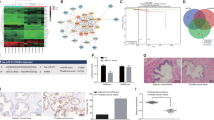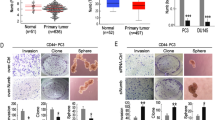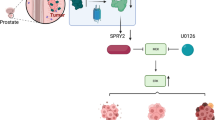Abstract
Background:
The suppressor of cytokine signaling 1 (SOCS1) gene is repressed in prostate cancer (PCa) by epigenetic silencing and microRNA miR30d. Increased expression of the SOCS1-targeting miR30d correlates with higher biochemical recurrence, suggesting a tumor suppressor role of SOCS1 in PCa, but the underlying mechanisms are unclear. We have shown that SOCS1 inhibits MET receptor kinase signaling, a key oncogenic pathway in cancer progression. Here we evaluated the role of SOCS1 in attenuating MET signaling in PCa cells and tumor growth in vivo.
Methods:
MET-overexpressing human DU145 and PC3 PCa cell lines were stably transduced with SOCS1, and their growth, migration and invasion of collagen matrix were evaluated in vitro. Cells expressing SOCS1 or the control vector were evaluated for tumor growth in NOD.scid.gamma mice as xenograft or orthotopic tumors.
Results:
HGF-induced MET signaling was attenuated in SOCS1-expressing DU145 and PC3 cells. Compared with vector control cells, SOCS1-expressing cells showed reduced proliferation and impaired migration following HGF stimulation. DU145 and PC3 cells showed marked ability to invade the collagen matrix following HGF stimulation and this was attenuated by SOCS1. As xenografts, SOCS1-expressing PCa cells showed significantly reduced tumor growth compared with vector control cells. In the orthotopic tumor model, SOCS1 reduced the growth of primary tumors and metastatic spread. Intriguingly, the SOCS1-expressing DU145 and PC3 tumors showed increased collagen deposition, associated with increased frequency of myofibroblasts.
Conclusions:
Our findings support the tumor suppressor role of SOCS1 in PCa and suggest that attenuation of MET signaling is one of the underlying mechanisms. SOCS1 in PCa cells also appears to prevent the tumor-promoting functions of cancer-associated fibroblasts.
This is a preview of subscription content, access via your institution
Access options
Subscribe to this journal
Receive 4 print issues and online access
$259.00 per year
only $64.75 per issue
Buy this article
- Purchase on Springer Link
- Instant access to full article PDF
Prices may be subject to local taxes which are calculated during checkout








Similar content being viewed by others
References
Siegel RL, Miller KD, Jemal A . Cancer statistics, 2016. CA Cancer J Clin 2016; 66: 7–30.
Denmeade SR, Isaacs JT . A history of prostate cancer treatment. Nat Rev Cancer 2002; 2: 389–396.
Shen MM, Abate-Shen C . Molecular genetics of prostate cancer: new prospects for old challenges. Genes Dev 2010; 24: 1967–2000.
Haverkamp J, Charbonneau B, Ratliff TL . Prostate inflammation and its potential impact on prostate cancer: a current review. J Cell Biochem 2008; 103: 1344–1353.
Culig Z, Puhr M . Interleukin-6: a multifunctional targetable cytokine in human prostate cancer. Mol Cell Endocrinol 2012; 360: 52–58.
Starr R, Willson TA, Viney EM, Murray LJ, Rayner JR, Jenkins BJ et al. A family of cytokine-inducible inhibitors of signalling. Nature 1997; 387: 917–921.
Flowers LO, Subramaniam PS, Johnson HM . A SOCS-1 peptide mimetic inhibits both constitutive and IL-6 induced activation of STAT3 in prostate cancer cells. Oncogene 2005; 24: 2114–2120.
Neuwirt H, Puhr M, Santer FR, Susani M, Doppler W, Marcias G et al. Suppressor of cytokine signaling (SOCS)-1 is expressed in human prostate cancer and exerts growth-inhibitory function through down-regulation of cyclins and cyclin-dependent kinases. Am J Pathol 2009; 174: 1921–1930.
Yoshikawa H, Matsubara K, Qian GS, Jackson P, Groopman JD, Manning JE et al. SOCS-1, a negative regulator of the JAK/STAT pathway, is silenced by methylation in human hepatocellular carcinoma and shows growth- suppression activity. Nat Genet 2001; 28: 29–35.
Galm O, Yoshikawa H, Esteller M, Osieka R, Herman JG . SOCS-1, a negative regulator of cytokine signaling, is frequently silenced by methylation in multiple myeloma. Blood 2003; 101: 2784–2788.
Liu TC, Lin SF, Chang JG, Yang MY, Hung SY, Chang CS . Epigenetic alteration of the SOCS1 gene in chronic myeloid leukaemia. Br J Haematol 2003; 123: 654–661.
Fukushima N, Sato N, Sahin F, Su GH, Hruban RH, Goggins M . Aberrant methylation of suppressor of cytokine signalling-1 (SOCS-1) gene in pancreatic ductal neoplasms. Br J Cancer 2003; 89: 338–343.
Sasi W, Sharma AK, Mokbel K . The role of suppressors of cytokine signalling in human neoplasms. Mol Biol Int 2014; 2014: 630797.
Rottapel R, Ilangumaran S, Neale C, La Rose J, Ho JM, Nguyen MH et al. The tumor suppressor activity of SOCS-1. Oncogene 2002; 21: 4351–4362.
Hanada T, Kobayashi T, Chinen T, Saeki K, Takaki H, Koga K et al. IFNgamma-dependent, spontaneous development of colorectal carcinomas in SOCS1-deficient mice. J Exp Med 2006; 203: 1391–1397.
Yeganeh M, Gui Y, Kandhi R, Bobbala D, Tobelaim WS, Saucier C et al. Suppressor of cytokine signaling 1-dependent regulation of the expression and oncogenic functions of p21 in the liver. Oncogene 2016; 35: 4200–4211.
Pichiorri F, Suh SS, Ladetto M, Kuehl M, Palumbo T, Drandi D et al. MicroRNAs regulate critical genes associated with multiple myeloma pathogenesis. Proc Natl Acad Sci USA 2008; 105: 12885–12890.
Jiang S, Zhang HW, Lu MH, He XH, Li Y, Gu H et al. MicroRNA-155 functions as an OncomiR in breast cancer by targeting the suppressor of cytokine signaling 1 gene. Cancer Res 2010; 70: 3119–3127.
Suzuki M, Shigematsu H, Shivapurkar N, Reddy J, Miyajima K, Takahashi T et al. Methylation of apoptosis related genes in the pathogenesis and prognosis of prostate cancer. Cancer Lett 2006; 242: 222–230.
Kobayashi N, Uemura H, Nagahama K, Okudela K, Furuya M, Ino Y et al. Identification of miR-30d as a novel prognostic maker of prostate cancer. Oncotarget 2012; 3: 1455–1471.
Gui Y, Yeganeh M, Ramanathan S, Leblanc C, Pomerleau V, Ferbeyre G et al. SOCS1 controls liver regeneration by regulating HGF signaling in hepatocytes. J Hepatol 2011; 55: 1300–1308.
Zhu ML, Kyprianou N . Androgen receptor and growth factor signaling cross-talk in prostate cancer cells. Endocr Relat Cancer 2008; 15: 841–849.
Cen B, Mahajan S, Wang W, Kraft AS . Elevation of receptor tyrosine kinases by small molecule AKT inhibitors in prostate cancer is mediated by Pim-1. Cancer Res 2013; 73: 3402–3411.
Chen Y, Xin X, Li J, Xu J, Yu X, Li T et al. RTK/ERK pathway under natural selection associated with prostate cancer. PLoS One 2013; 8: e78254.
Pisters LL, Troncoso P, Zhau HE, Li W, von Eschenbach AC, Chung LW . c-met proto-oncogene expression in benign and malignant human prostate tissues. J Urol 1995; 154: 293–298.
Humphrey PA, Zhu X, Zarnegar R, Swanson PE, Ratliff TL, Vollmer RT et al. Hepatocyte growth factor and its receptor (c-MET) in prostatic carcinoma. Am J Pathol 1995; 147: 386–396.
Knudsen BS, Gmyrek GA, Inra J, Scherr DS, Vaughan ED, Nanus DM et al. High expression of the Met receptor in prostate cancer metastasis to bone. Urology 2002; 60: 1113–1117.
Varkaris A, Corn PG, Gaur S, Dayyani F, Logothetis CJ, Gallick GE . The role of HGF/c-Met signaling in prostate cancer progression and c-Met inhibitors in clinical trials. Expert Opin Investig Drugs 2011; 20: 1677–1684.
Yasuda K, Nagakawa O, Akashi T, Fujiuchi Y, Koizumi K, Komiya A et al. Serum active hepatocyte growth factor (AHGF) in benign prostatic disease and prostate cancer. Prostate 2009; 69: 346–351.
Gupta A, Karakiewicz PI, Roehrborn CG, Lotan Y, Zlotta AR, Shariat SF . Predictive value of plasma hepatocyte growth factor/scatter factor levels in patients with clinically localized prostate cancer. Clin Cancer Res 2008; 14: 7385–7390.
Russo AL, Jedlicka K, Wernick M, McNally D, Kirk M, Sproull M et al. Urine analysis and protein networking identify met as a marker of metastatic prostate cancer. Clin Cancer Res 2009; 15: 4292–4298.
Hurle RA, Davies G, Parr C, Mason MD, Jenkins SA, Kynaston HG et al. Hepatocyte growth factor/scatter factor and prostate cancer: a review. Histol Histopathol 2005; 20: 1339–1349.
Okamoto M, Lee C, Oyasu R . Interleukin-6 as a paracrine and autocrine growth factor in human prostatic carcinoma cells in vitro. Cancer Res 1997; 57: 141–146.
Gui Y, Yeganeh M, Donates YC, Tobelaim WS, Chababi W, Mayhue M et al. Regulation of MET receptor tyrosine kinase signaling by suppressor of cytokine signaling 1 in hepatocellular carcinoma. Oncogene 2015; 34: 5718–5728.
Birchmeier C, Birchmeier W, Gherardi E, Vande Woude GF . Met, metastasis, motility and more. Nat Rev Mol Cell Biol 2003; 4: 915–925.
Lu P, Weaver VM, Werb Z . The extracellular matrix: a dynamic niche in cancer progression. J Cell Biol 2012; 196: 395–406.
Havens AM, Pedersen EA, Shiozawa Y, Ying C, Jung Y, Sun Y et al. An in vivo mouse model for human prostate cancer metastasis. Neoplasia 2008; 10: 371–380.
Calvi EN, Nahas FX, Barbosa MV, Calil JA, Ihara SS, Silva Mde S et al. An experimental model for the study of collagen fibers in skeletal muscle. Acta Cir Bras 2012; 27: 681–686.
Kalluri R, Zeisberg M . Fibroblasts in cancer. Nat Rev Cancer 2006; 6: 392–401.
Davies G, Jiang WG, Mason MD . Cell-cell adhesion molecules and signaling intermediates and their role in the invasive potential of prostate cancer cells. J Urol 2000; 163: 985–992.
Taylor BS, Schultz N, Hieronymus H, Gopalan A, Xiao Y, Carver BS et al. Integrative genomic profiling of human prostate cancer. Cancer Cell 2010; 18: 11–22.
Kumar A, Coleman I, Morrissey C, Zhang X, True LD, Gulati R et al. Substantial interindividual and limited intraindividual genomic diversity among tumors from men with metastatic prostate cancer. Nat Med 2016; 22: 369–378.
Cancer Genome Atlas Research N. The molecular taxonomy of primary prostate cancer. Cell 2015; 163: 1011–1025.
Kazi JU, Kabir NN, Flores-Morales A, Ronnstrand L . SOCS proteins in regulation of receptor tyrosine kinase signaling. Cell Mol Life Sci 2014; 71: 3297–3310.
Kleinman HK, Martin GR . Matrigel: basement membrane matrix with biological activity. Semin Cancer Biol 2005; 15: 378–386.
Augsten M . Cancer-associated fibroblasts as another polarized cell type of the tumor microenvironment. Front Oncol 2014; 4: 62.
Chlenski A, Liu S, Guerrero LJ, Yang Q, Tian Y, Salwen HR et al. SPARC expression is associated with impaired tumor growth, inhibited angiogenesis and changes in the extracellular matrix. Int J Cancer 2006; 118: 310–316.
Haroon ZA, Amin K, Lichtlen P, Sato B, Huynh NT, Wang Z et al. Loss of metal transcription factor-1 suppresses tumor growth through enhanced matrix deposition. FASEB J 2004; 18: 1176–1184.
Calabrese V, Mallette FA, Deschenes-Simard X, Ramanathan S, Gagnon J, Moores A et al. SOCS1 links cytokine signaling to p53 and senescence. Mol Cell 2009; 36: 754–767.
Smith M, De Bono J, Sternberg C, Le Moulec S, Oudard S, De Giorgi U et al. Phase III study of cabozantinib in previously treated metastatic castration-resistant prostate cancer: COMET-1. J Clin Oncol 2016; 34: 3005–3013.
Alumkal JJ, Beer TM . Raising the bar for therapeutic trials in advanced prostate cancer. J Clin Oncol 2016; 34: 2958–2960.
Ge D, Gao AC, Zhang Q, Liu S, Xue Y, You Z . LNCaP prostate cancer cells with autocrine interleukin-6 expression are resistant to IL-6-induced neuroendocrine differentiation due to increased expression of suppressors of cytokine signaling. Prostate 2012; 72: 1306–1316.
Acknowledgements
We thank Dr Robert Day for providing PCa cell lines. AVH and RK are supported by Master’s degree scholarship from the Faculty of Medicine, Université de Sherbrooke. DB is a recipient of a postdoctoral fellowship from FRQS. CRCHUS is an FRQS-funded research center. This work was supported by Movember Discovery Grant from Prostate Cancer Canada (Grant number D2013-20).
Author information
Authors and Affiliations
Corresponding author
Ethics declarations
Competing interests
The authors declare no conflict of interest.
Additional information
Supplementary Information accompanies the paper on the Prostate Cancer and Prostatic Diseases website
Supplementary information
Rights and permissions
About this article
Cite this article
Villalobos-Hernandez, A., Bobbala, D., Kandhi, R. et al. SOCS1 inhibits migration and invasion of prostate cancer cells, attenuates tumor growth and modulates the tumor stroma. Prostate Cancer Prostatic Dis 20, 36–47 (2017). https://doi.org/10.1038/pcan.2016.50
Received:
Revised:
Accepted:
Published:
Issue Date:
DOI: https://doi.org/10.1038/pcan.2016.50
This article is cited by
-
Simplified algorithm for genetic subtyping in diffuse large B-cell lymphoma
Signal Transduction and Targeted Therapy (2023)
-
Long noncoding RNA CASC2 suppresses esophageal squamous cell carcinoma progression by increasing SOCS1 expression
Cell & Bioscience (2019)
-
Expression of SOCS1 and the downstream targets of its putative tumor suppressor functions in prostate cancer
BMC Cancer (2017)



